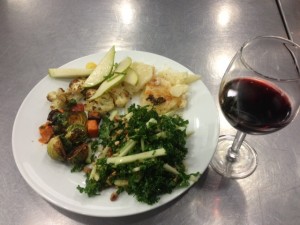 After completing my essential knife skills class at The New School of Cooking, my dream of mastering culinary knife techniques in a single afternoon was sliced, diced, chopped and turned into julienne fries.
After completing my essential knife skills class at The New School of Cooking, my dream of mastering culinary knife techniques in a single afternoon was sliced, diced, chopped and turned into julienne fries.
I naively went into the class thinking I could learn a secret culinary knife trick that would jump start my ability to use a chef’s knife. The class was more of an introduction to essential knife skills.
It was a good class for a beginner like myself, but many in the class were clearly looking for a higher level of training.
The first hour of the three-hour class was a lecture on the types of knives and a discussion on cutting techniques. The second part of the class I sliced, diced, chopped, chiffonaded and julienned vegetables with a chef’s knife. I even was able to supreme an orange.
At the end, I shared a meal made from the fruits and vegetable used in the class with my fellow chefs in training. We had a surprisingly good meal consisting of kale salad, potato gratin and brussels sprouts with a salsa verde.
Lessons learned:
– Always use the claw when using a knife in the kitchen.
– There is no shortcut to mastering the knife. Practice, Practice, Practice is the only way to get better.
– The chef’s knife and the paring knife are the only essential knives needed in the kitchen. The other knives can be helpful, but not required.
– Cutting up fresh herbs is extremely easy and makes your food taste much better.
– For best control of a chef’s knife, use the pinch grip.
– If prepared properly, a kale salad can taste really good.
– Always hold a chef’s knife before you buy it. You need to find a knife that feels good in your hand.

 Today is my nephew’s birthday, so I am making cupcakes using his favorite cold cereals as ingredients. I am baking a dozen Trix cupcakes and a dozen Cocoa Puffs cupcakes.
Today is my nephew’s birthday, so I am making cupcakes using his favorite cold cereals as ingredients. I am baking a dozen Trix cupcakes and a dozen Cocoa Puffs cupcakes.








